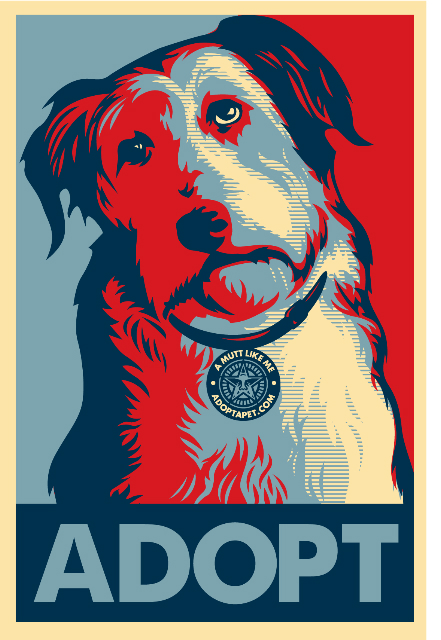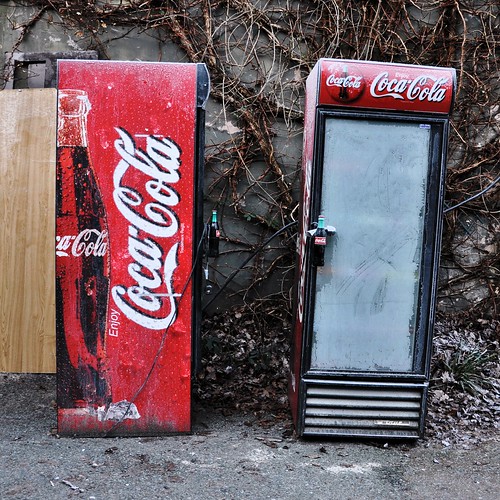An amusing Talk of the Town piece by Ben McGrath in this week’s New Yorker puts Drank (Consumed: December 31, 2008) to a taste test of sorts — and suggests that an “anti energy drink” may be particularly in sync with a jittery cultural moment. (By the way, I happen to have very reliable information that this piece was actuallly written before my Drank column appeared, so I’m not suggesting they’re following or getting ideas from me; indeed I’m never suggesting that with these updates.)
I must admit that when I wrote about the Buddha Machine (Consumed: July 29, 2007), it had already gotten enough attention that I figured I would basically be the last person to do so. But since its creators keep coming up with new iterations and spins on the device, and people keep discovering it, it has proven remarkably resilient. Here is Sasha Frere-Jones’ brief Q&A with Buddha Machine co-creator Christiaan Viant.
 On a similar note, Uglydolls (Consumed: February 15, 2004) have gotten a fresh wave of press because Sasha Obama has one.
On a similar note, Uglydolls (Consumed: February 15, 2004) have gotten a fresh wave of press because Sasha Obama has one.
The Newark Star-Ledger says: “As Seen on TV! Pitchmen Reign During Hard Times.” The creator of the PedEgg asserts: “In bad economic times, our business gets better.”Also in the piece is Billy Mays, subject of October 24, 2008 Consumed.
The new (forthcoming) Palm Pre phone is getting lots of attention, and I’ve read assessments both positive and not-so-much. Here’s the FT writeup: “Palm, a former icon of technology that was largely given up for dead by Wall Street, has emerged as an unlikely star from this week’s annual Consumer Electronics Show with a new product that many tech analysts are already comparing with Apple’s iPhone.” Remember when the Treo was cutting edge? Well: Consumed January 25, 2004.
Posted Under:
Update by Rob Walker on January 12, 2009
Comments Off on Dept. of update: Drank, Billy Mays, Uglydolls, etc.
 TAP DANCE
TAP DANCE
Want to stand out in a category that’s all about subtracting? Add something.
This week in Consumed, Pur Flavor Options, which allow you to add flavor to filtered tap water.
It may seem surprising, then, that a filter maker would attempt a kind of jujitsu move on the notion of purity: What if you took water with all the bad stuff screened out and . . . added something to it? …
But if Flavor Options suggests that progress on the front lines in the marketplace is incremental, it also offers proof of just how resistant the marketplace can be to limits. At a certain point, you would think, the race to purity gets won; eventually, you cannot get purer than pure. And yet, just as you can never actually drive to the horizon, the end point of “new and improved” simply does not exist.
Read the column in the January 11, 2009, issue of The New York Times Magazine, or here.
Consumed archive is here, and FAQ is here; The Times‘ Consumed RSS feed is here.
Consumed Facebook page is here.
“Letters should be addressed to Letters to the Editor, Magazine, The New York Times, 620 Eighth Avenue, 6th Floor, New York, N.Y. 10018. The e-mail address is magazine@nytimes.com. All letters should include the writer’s name, address and daytime telephone number. We are unable to acknowledge or return unpublished letters. Letters may be edited for length and clarity.”
Posted Under:
Consumed,
Progress by Rob Walker on January 10, 2009
Comments Off on In The New York Times Magazine: Pur Flavor Options

From Connect:
Stitch Spectacular will feature 41 pieces by artists from as far away as Calgary, Alberta, Canada.
Participants were selected by an impressive jury comprising Grace Bonney, founder of design*sponge website; Kate Bingaman-Burt, founder of the Obsessive Consumption website and assistant professor at Portland State University; and Torrey Stifel, studio coordinator at the Jepson Center for the Arts. Learn more about the judges and entries at www.stitchspectacular.com.
Dimensions Gallery
412 Martin Luther King Blvd.
Savannah, GA
January 9 through February 3. Opening reception January 9, 7-10 p.m. Closing reception January 30, 5-8 p.m.
Posted Under:
DIYism,
To Do by Rob Walker on January 9, 2009
Comments Off on To Do in Savannah: Stitch Spectacular

Shepard Fairey on Obey Giant site:
The day Obama stated his interest in adopting a dog from the shelter was a slightly brighter one for the approximately 7 million adoptable dogs & cats killed each year in this country. The staggering reality is that for each one sold at a pet store or by a breeder, another perfectly worthy one is killed. Our nations shelters are filled to capacity with all kinds of amazing adoptable animals including, as Obama put it, “Mutts like me.”
On the heels of Obama’s comment, I got a call from Pia Salk, an animal advocate who works with North America’s largest non-profit pet adoption website, Adopt-a-Pet.com. Pia simply asked if I might be willing to collaborate on a way to have my art help these animals.
Read the rest here.
Earlier: The Art of Politics in Consumed.
 Associated Press reviews the Polaroid PoGo, which is the brand’s comeback-attempt product in the post instant-film era. (I wrote about Polaroid’s unwinding of its actual instant-film business in Consumed, March 16, 2008).
Associated Press reviews the Polaroid PoGo, which is the brand’s comeback-attempt product in the post instant-film era. (I wrote about Polaroid’s unwinding of its actual instant-film business in Consumed, March 16, 2008).
The PoGo is a digital camera priced at $200, with a built-in printer — so it sort of recreates the classic Polaroid idea of the instant print. (You can see a company video here, and a demonstration video that I found too long to watch, here.)
Here’s what I thought was most interesting from the AP review:
The prints [are] grainy and the colors are slightly off, with faces tending toward a deathly blue-green….
As a camera, it’s primitive. It doesn’t have auto-focus, just a switch for infinity or close-up shots. The resolution is five megapixels, far below that of cheaper compact cameras. Neither of these things matter much for the quality of the prints, which are small and of low resolution anyway…
That all sounds bad … but maybe not.
The imperfections and limitations of actual Polaroid pictures were, in a way, part of their appeal.
I had been pretty skeptical of this product when I first heard about it, but, oddly enough, I find the flaws to be potentially the most attractive aspect of the PoGo. I wonder if any of the Polaroid diehards will, if not quite embrace it, at least be curious enough to give it a try — and if we’ll see some interesting creations as a result.
There’s already at least one PoGo prints Flickr pool. AP says the camera isn’t on the market until March or so, but I assume the “seeding” has begun (and for all I know that Flickr pool is a murketing effort from the company). But anyway I’m more curious now than I was when I first heard of the camera. We’ll see.
The Economist’s recent(ish) World in 2009 issue included a story about “no-nonsense brands” doing well in 2009, while those “priced for status are likely to suffer.”
This sounds in-line with much of the trend-pontification about the new-and-improved “values” of the 2009 consumer.
But the piece also said this:
Any brand built around do-gooding notions of organic, social responsibility or caring for the environment may need to rethinking, according to Interbrand, a marketing consultancy, as value for money rises up the consumers’ agenda.
Now, I don’t know what exactly Interbrand said. (Couldn’t find anything on their site about it.)
But if this assertion turns out to be correct, I wonder how it squares with the idea of “values.”
My thoughts on the “new thrift” are in this earlier Consumed. My thoughts on the limits of do-gooding sales pitches can be found in the final section of Buying In.
So: Thanks to all who answered the survey the other day. The giveaway winner (chosen by counting how many people gave me an address and having E pick a number without knowing why) is C.C., in Butler, PA. You know who you are! I hope. Actually, even if you don’t know who you are, I’m sending the DVD to the address you provided, so watch your mailbox.
All in all it was a pretty interesting exercise, with some surprises. Not surprising of course — in fact it’s inevitable — is contradiction. Notably, several people mentioned liking the Flickr Interludes — and several named them as their least favorite part of the site (or as one respondent put it: “Flickr interlude. WTF?”)
I’m mulling the feedback, and there are a few comments I received that I’ll revisit in the days ahead.
I must say the most salient comment, from my point of view, was: “I wonder how you do this site without $$$ compensation.” This gets directly at the reason for the survey in the first place: I enjoy the site, but I simply can’t justify spending as much time on it as I do.
Also there were several suggestions about adding outside contributors in various ways that I found extremely helpful, and that I’ll revisit in the days ahead after I’ve thought them through.
Meanwhile, if you’re interested, some highlights after the jump. And obviously if you’d like to offer feedback about this feedback, feel free. Please continue…
Peddling a coinage that supposedly summarizes a trend is a stalwart promotional tactic. Today, for instance, I got a pitch that was built around this coinage: “deepre(ce)ssion.”
“There is a thin line between the play on words ‘deepre(ce)ssion’ and ‘deep recession,'” the pitch continued, going on to say that whoever these people are, they are a great resource for expertise for a story “on any subject relating to the oncoming deep recession.” Noted.
But I must say, “deepre(ce)ssion” is the worst portmanteau I have encountered in some time. I’m not sure how it qualifies as a play on words, nor do I understand what idea it is trying to communicate. It’s also not fun to say.
It is portmanteau that has failed.
It is a coinage manqué.
It is — yes! — a portmanqué.
James Surowiecki, on his NYer blog, asks:
Has any regular blogger—someone who’s posting a sizeable amount of content every day—written a great book (whether in terms of critical acclaim or public influence)? I realize that’s a completely old-media question (why, after all, should books be the criterion of anything?), but I’d still be interested to hear people’s answers.
Unfortunately there appears to be no way to leave a comment, or contact Suroweicki, so I’m not sure how he’s going to get answers.
Anyway, I would say that a few things that leap to mind are that Julie/Julia book (blogger who cooked from Julia Childs cookbook and wrote about it), very well-reviewed and sold well; that book by the waiter who ranted anonymously on a blog, I think that was well-received, and sold welll; and I guess the stuff white people like blog/book, I think that has done well and people like Kurt Andersen think that it’s “smart.”
Maybe none of those count as critical acclaim and public influence, I’m not sure. But those are the ones I can think of.
In general, publishers have thrown a lot of money at bloggers, but most of those efforts have not been successful.
Later this week I’ll come back to the survey I posted the other day (so you still have time to weigh in if you want), but today I am going to reprise something I did last year: my quasi-data-driven list of the 10 best songs of the year just ended.
First the list; then, after the jump, for those curious, an absurdly long breakdown of related personal-listening data that (partly) shaped the list, and some mild observations about the problem with “best of the year” lists.
- “Poison Dart,” The Bug featuring Warrior Queen
- “Count It Off,” Saturday Knights
- “Albert Goes West,” Nick Cave & The Bad Seeds
- “Da Feelin’,” Nightmares On Wax
- “Get It Up (Radioclit mix),” Esau Mwamwaya, Santogold, M.I.A
- “Bag of Hammers,” Thao
- “Ooh Yeah,” Moby
- “Thinking About You,” Irma Thomas
- “You Want the Candy,” The Raveonettes
- “Play Your Part (Pt. 1),” Girl Talk
Okay. So I’ll quickly acknowledge that Cousin Lymon is going to give me shit about the Raveonettes and Moby, but the explanation that follows should not be taken as defensive! Please continue…
So maybe you already knew this, but I just noticed that the number-one selling paid app for the iPhone is: iFart.
It makes a variety of fart noises.
There’s a YouTube demo here, if you need one. The app costs 99 cents.
According to WiredNews, sales hit 10,000 a day in late December. Also this:
That’s pretty impressive, considering Apple previously didn’t believe fart applications met the standards of the App Store. In September, Apple rejected a similar novelty app called Pull My Finger on the grounds that it had “limited utility.” Just recently Apple reversed that decision and approved a number of other fart apps as well.
Take note that there are “a number of other fart apps.” I suppose that when trendmeisters earnestly ruminate on the new downturn-era insistence on only spending on things that have real value and utility, they’re talking about … iFart. Therefore, I look forward to the digital sneeze-powder or 21st century fake dog-doo that will lead us back to better economic times.
 SLOW PITCH
SLOW PITCH
An ‘anti-energy’ drink’s novel image: chic … or shameful?
This week in Consumed, a beverage containing allegedly relaxing ingredients such as valerian root, melatonin and rose hips, but that skips the health-store image in favor of one striving for hip-hop chic — and whose name happens to echo slang for sipping prescription cough syrup.
This has attached some controversy to Drank, as well as to a rival drink called Purple Stuff, made by a different Houston company. “One of the most asinine things I have ever seen,” a public-health professor commented in one Houston Chronicle article that also included complaints from local religious figures and rappers. Not surprising, right? “I’m a little shocked” at the criticism, Peter Bianchi, the inventor of Drank, told me. “We’re not advocating drug use at all,” he continued, but merely offering an innocuous beverage to anyone who feels a little stressed out — carbonated counterprogramming, as it were, to the firmly established “energy drink” category.
Read the column in the January 4, 2009 issue of The New York Times Magazine, or here.
Consumed archive is here, and FAQ is here. Consumed Facebook page is here.
“Letters should be addressed to Letters to the Editor, Magazine, The New York Times, 620 Eighth Avenue, 6th Floor, New York, N.Y. 10018. The e-mail address is magazine@nytimes.com. All letters should include the writer’s name, address and daytime telephone number. We are unable to acknowledge or return unpublished letters. Letters may be edited for length and clarity.”
Posted Under:
Consumed by Rob Walker on January 3, 2009
Comments Off on In The New York Times Magazine: Drank
So it’s the end of the year. Time for a quick wrapup and an announcement or two.
Also there’s a survey, and to get people to participate, I’ll be giving away a still-in-the-shrinkwrap Blu-ray DVD of the acclaimed documentary Helvetica. (This was given to me, but I own a regular DVD version already and do not have a Blu-ray machine.)
1. Consumed: In 2009, I’ll be writing Consumed three out of every four weeks, as opposed to every week. I’ve now been writing the column for five years, and asked for a reduced schedule because I would like to free up time to write more feature stories, among other things. Am I nervous about reducing the frequency of my steadiest cashflow source? Very much so. But sometimes fear is a good motivator.
2. Back in February I announced — or admitted — that I’d started a Facebook page for Consumed. Recently the page passed the 500-fan mark. That’s nice. Thanks to those of you who fanned up in 2008.
3. I’ve been giving a lot of thought to the future of this site. I’ve considered everything from expanding it by including contributions from others, to shutting it down altogether. I have drawn no conclusions, but everything is still on the table.
Which brings me to:
The Murketing Survey: It’s only a few questions, pretty straightforward stuff. You can answer anonymously, but obviously if you want to win the Helvetica DVD you’d have to tell me where to send it, which would likely entail revealing your name. Totally up to you. Click Here to take survey. [Survey closed — thanks, participants!]
Thanks…
And happy new year…
I noted earlier in the sidebar the obituary of Abbott Combes. He was known to colleagues as Kit, and he was in fact my colleague: an editor at the Times Magazine who worked on the copy desk while I was on staff as a story editor, and in the building, back in the late 1990s. Every so often we’d have lunch in Bryant Park. I liked him quite a bit, and had tremendous professional respect for him. A very smart guy, and, truly, an original. I suppose he could be a little sharp with people sometimes, but that’s because he had standards, and an agile mind. So when Kit said he liked something I wrote, it meant a lot — because he didn’t say it often, and he certinaly never said it without meaning it.
He also didn’t write often, but when he did, his stuff was very good: His writer’s voice was smooth and unpredictable at the same time, and that’s not easy.
Here is a short essay he wrote about his necktie habit, written back in 1999. What you’ll find in reading it, I believe, is a skill at suggesting a lot of life and wisdom between the lines. This can only be done subtly — without overpowering the easygoing and very accessible subject at hand. A hard thing to do is draw attention to the writing, and not to the writer. Here, it gets done.
Here is another essay, from a few years earlier, about another sartorial habit. This time I’ll quote: “I am the 50-something guy you may have seen in summertime Manhattan going about his business clad in coat and tie, dressy loafers (no socks) and what used to be called Bermuda shorts. I didn’t set out to become an ensign of men’s style, but one I seem to have become, recognized uptown and down by my . . . knees.” This is no joke. When I picture Kit, I picture him in his Memorial Day-to-Labor Day iteration: The shorts and the loafers and the jacket, and looking like a million bucks. I have known a lot of people who supposedly have style. I will say nothing negative about them, but I will say: Friends, this guy had style.
One more, and I’ll stop: A short essay called “Family Portrait,” from 2006. I won’t attempt to sum it up, but I remember when I read it the first time being mightily impressed at the economy of the piece, at (again) his skill in communicating by omission, always keeping an easy and readable tone. I will also say — and I think he would almost expect me to — that having been on the writer/editor side of Kit’s strict copy desk persona, I have a feeling I’d have had to argue pretty hard to get away with something like that “Sobeit” he slips in at one point.
Then again, I’ve always believed that when it comes to writing, to the use of language, you earn your way to breaking rules. And he earned it. So be it.
More of his writing is here.
I don’t get to the Times much these days, and so it’s been a while since I chatted with Kit face to face, or even by phone. But I feel a loss at the idea of him not there … in the shorts and the loafers … calling me out on some bit of linguistic bullshit or other. Wherever you may be, sir, you are missed.
Posted Under:
Obituaries by Rob Walker on December 30, 2008
Comments Off on Kit
 On a similar note, Uglydolls (Consumed: February 15, 2004) have gotten a fresh wave of press because Sasha Obama has one.
On a similar note, Uglydolls (Consumed: February 15, 2004) have gotten a fresh wave of press because Sasha Obama has one.



 "
"
 TAP DANCE
TAP DANCE















 Kim Fellner's book
Kim Fellner's book  A
A